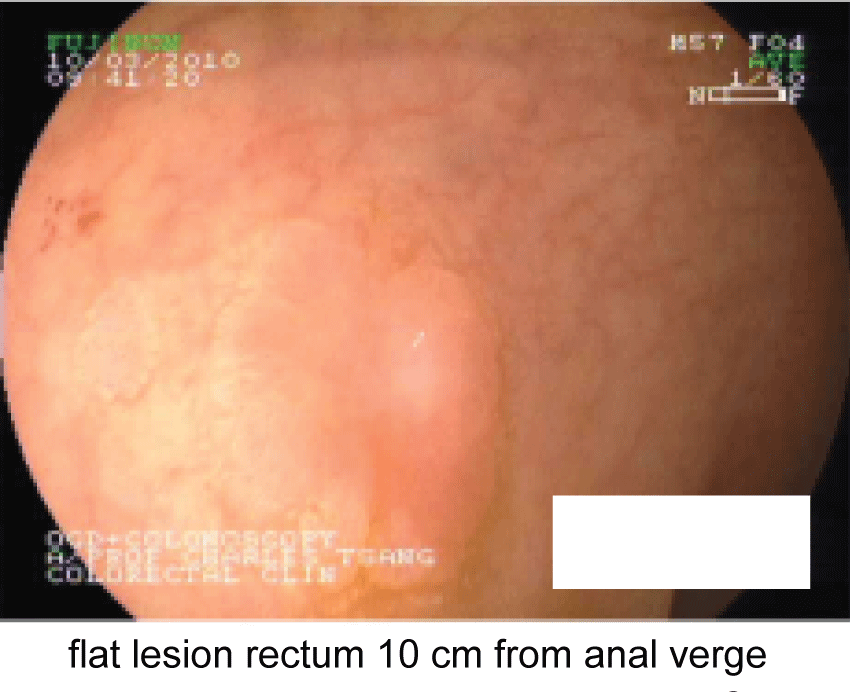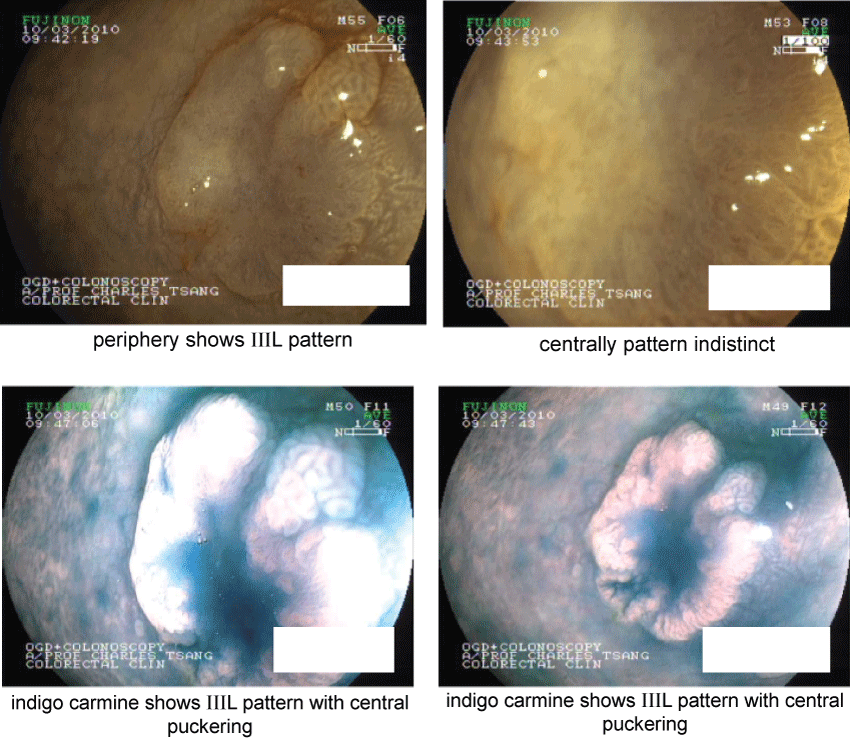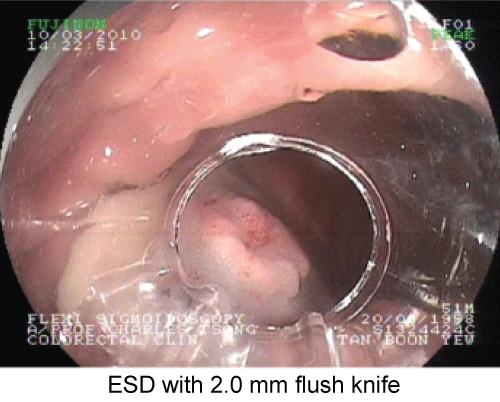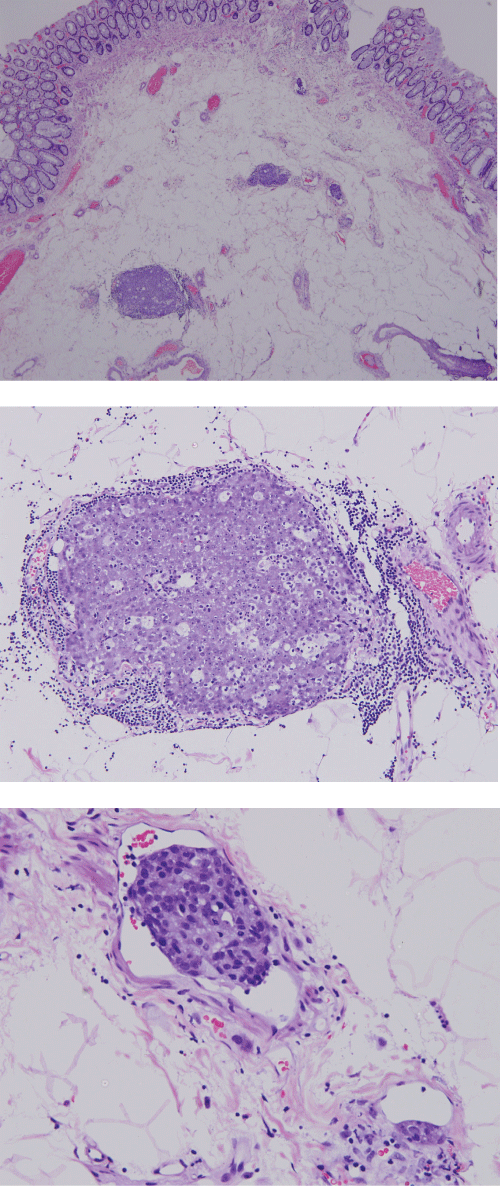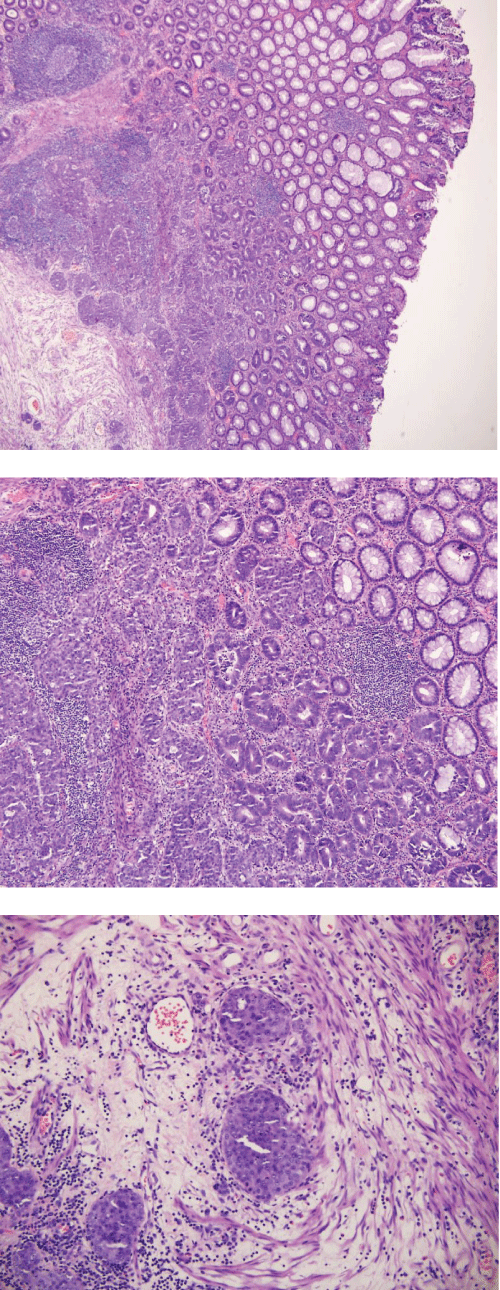Journal of Clinical Gastroenterology and Treatment
Discordance Between Endoscopic & Histological Findings Warrant a Reassessment of the Pathological Specimen
Koh ZL Sharon1, Yamamoto H2 and Tsang BS Charles3*
1Division of Colorectal Surgery, University Surgical Cluster, National University Health System, Singapore
2Endoscopic Research and International Education, Jichi Medical University, Japan
3Department of Surgery, Yong Loo Lin School of Medicine, National University of Singapore, Singapore
*Corresponding author:
Dr. Tsang BS Charles, Senior Consultant, Adjunct Associate Professor, Department of Surgery, Yong Loo Lin School of Medicine, National University of Singapore, Singapore, E-mail: drcharlestsang@colorectalclinic.com
J Clin Gastroenterol Treat, JCGT-2-029, (Volume 2, Issue 3), Case Report; ISSN: 2469-584X
Received: May 17, 2016 | Accepted: June 13, 2016 | Published: July 01, 2016
Citation: Sharon KZL, Yamamoto H, Charles TBS (2016) Discordance Between Endoscopic & Histological Findings Warrant a Reassessment of the Pathological Specimen. J Clin Gastroenterol Treat 2:029. 10.23937/2469-584X/1510029
Copyright: © 2016 Sharon KZL, et al. This is an open-access article distributed under the terms of the Creative Commons Attribution License, which permits unrestricted use, distribution, and reproduction in any medium, provided the original author and source are credited.
Abstract
We report a 52-year-old man who underwent a screening colonoscopy, which revealed a sessile rectal polyp with neoplastic features on magnified chromo-endoscopy. Based on pit pattern analysis and Endoscopic Ultrasound (EUS) (EUS), Endoscopic Submucosal Dissection (ESD) was performed for a presumptive diagnosis of an early rectal neoplastic lesion (limited to the mucosa and upper third of the submucosa). Histopathological examination however reported it to be a submucosal rectal lipoma with overlying regenerative changes over the mucosa. A second opinion was sought due to the discordance between the histology report and the pit pattern analysis of the lesion. Following a reassessment of the pathological specimen, it was revealed that the initial endoscopic diagnosis of a likely malignant neoplastic change within the mucosal lesion was accurate. In view of the revised histology report of a poorly differentiated adenocarcinoma with lymphatic invasion, he subsequently underwent a formal laparoscopic anterior resection for a T1N0 rectal cancer. Postoperative recovery was uneventful, and the patient remains well, in remission.
Keywords
ESD, Reassessment, Discordance, T1 rectal carcinoma, Lipoma
Introduction
Improvements in endoscopic mucosal resection (EMR) and endoscopic submucosal dissection (ESD) have facilitated the removal of early colorectal cancers, even those > 20 mm [1-6]. Whilst sufficient for superficial early-invading lesions, deeper-invading submucosal cancers sometimes have lymph node metastases [7]. Thus, it is paramount that the diagnoses of such cancers be ascertained before endoscopic resection as these patients will be better treated with a formal oncologic resection.
Chromoendoscopy, using the pit pattern analysis developed by Kudo et al. [8], Tobaru et al. [9], and Yoshida et al. [10], is a powerful tool for making qualitative diagnosis of colorectal lesions. In the same vein, advances in endoscopic technologies such as narrow band imaging (NBI) systems and flexible spectral imaging color enhancement (FICE) have seen wider use in recent years. Hence, the push for accurate endoscopic diagnosis of early colorectal cancer to enable a minimal invasive approach for the early detection and treatment of these lesions is thought to reduce colorectal carcinoma mortality [11].
Colonic lipoma is the third most common benign colonic tumour following hyperplastic and adenomatous polyps [12]. Its incidence has been reported to range between 0.2 to 4.4% [13,14] hence, is relatively rare. Approximately 90% of these colonic lipomata arise from the submucosal layer, the overlying mucosa remains uninvolved. There are reports of pseudomalignant endoscopic features of ulceration and stiffness on palpation with endoscopic forceps [15,16].
Case Report
A 52-year-old asymptomatic Chinese male with a past history of hemorrhoidectomy 5 years ago underwent a screening colonoscopy in March 2010. His endoscopic evaluation revealed a flat polyp 10 cm from the anal verge measuring approximately 20 mm by 15 mm at the posterior wall of the distal rectum. It was in an extraperitoneal location.
A Fujinon high-definition magnifying colonoscope (EC-590ZW/L, Fujifilm Medical, Tokyo, Japan) was used and the polyp was examined using both FICE and magnified chromo-endoscopy using indigo carmine dye (Image 1).
The margins of the lesion were very clear, demonstrating type IIIL pit pattern with central puckering - possibly type VI pattern. There were no endoscopic features of reactive inflammatory change. It was strongly suggestive for a mucosal neoplastic lesion. An endoscopic ultrasound evaluation was performed using a Fujifulm Medical SP 102 system with a mini probe at 20 mHz. It confirmed a superficial lesion, likely without submucosal invasion.
He underwent an endoscopic submucosal dissection (ESD) of the lesion on the same day with 2.0 mm Flush knife (Image 2). The lesion was lifted with injection of MucoUp® (Seikagaku Corp, Tokyo, Japan), but there was difficulty in achieving sufficient lift in the central puckered region. The polyp measured 1.3 × 0.8 × 0.5 cm in maximum dimension. The entire specimen was processed in one block and histopathologic diagnosis was formally reported as a submucosal lipoma. The overlying large bowel mucosa showed regenerative changes. No dysplasia or malignancy was seen.
Due to the discordance between the endoscopic diagnosis and histology, a repeat pathology review was conducted. A review of the slides did not show any malignancy and it was concluded that the lesions being a lipoma can manifest pseudomalignant endoscopic features [15,16]. A second opinion was sought as advised by an expert endoscopist from the Department of Endoscopic Research and International Education in Jichi Medical University, Japan. Further new sections were obtained from the paraffin block and the new histopathological slides when reviewed, then showed a focus of definite tumour was identified in the submucosal lymphatics (Image 3). It is then believed that the initial tissue had not been embedded properly in the block, the mucosal abnormality only appeared after more than 90 sections. This further examination revealed a small focus of submucosa-invasive poorly differentiated adenocarcinoma (Image 4). Hence, we conclude that proper embedding and multiple sections are required to obtain the right diagnosis, especially so in cases where there is discordance between the histology and the endoscopic features.
Our patient subsequently underwent a Hand-Assisted Laparoscopic (HAL) anterior resection with a diverting loop ileostomy. The site of previous ESD excision was identified in the posterior rectum and there was no residual carcinoma seen in the rectosigmoid specimen nor any metastases in the lymph nodes harvested. His pathological stage remained that of T1N0M0.
Discussion
There have been several reports about lipomata of the gastrointestinal tract bearing pseudomalignant features on colonoscopy. We, the authors, are not aware of any reports of such lesions bearing pit patterns suggestive of neoplastic changes. Based on the principles of pit pattern analysis by Kudo et al. [8], these vascular changes are limited to that of the surface mucosal layer, and these have been widely used to assess colorectal lesions and invasion depths. Narrow-Band Imaging (NBI) is an image-enhanced endoscopy that involves the use of 3 optical filters for sequential red-blue-green (RBG) illumination of the video-endoscopic target and narrows the bandwidth of the spectral transmittance [17-19]. This enhances the visualization of surface and vascular patterns using the same principles by Kudo et al. [8] NBI magnification of colorectal tumors has been reported to correlate well with the histopathological grade and invasion depth of tumors [20,21].
Flexible spectral imaging color enhancement (FICE) is another image-enhanced endoscopy, which, unlike NBI, uses spectral estimation technology to construct narrow band images and reconstruct images at different wavelengths. This is based on images of white-light endoscopy. Similar to NBI, it can enhance surface structure and vascular patterns, enabling the endoscopist to distinguish neoplastic from non-neoplastic lesions [22-25].
Yoshida et al. [26] recently concluded that the classification of colorectal tumors by FICE magnification correlated well with the histopathological diagnoses, similar to findings for NBI magnification. Colorectal lesions can therefore be evaluated accurately, using the same diagnostic classifications as described by Hirata and Tanaka et al. [27] for NBI magnification.
Both Yoshida [26] and Okamoto et al. [28] have reported impressive diagnostic accuracies, sensitivities, specificities and predictive values for the use of image enhanced endoscopy in the diagnosis of early colorectal carcinomas, enabling the appropriate decision for endoscopic resection or formal surgical resection if high risk factors are present.
In our case, it is no wonder that there was concern when discordance arose between the endoscopic findings and histopathology report. From it, we learnt that correlation between the endoscopic diagnosis and the resulting histopathologic assessment must be ascertained and any discordance warrants a re-analysis of the specimen to ensure that proper embedding, sectioning and adequate analysis was performed. We performed a critical review of our case and realized that there was insufficient emphasis of the fact that ESD was performed for the patient. The pathologist initially sectioned the specimen as for a normal polypectomy specimen. Guidelines stipulated in the General Rules for Clinical and Pathological Studies on Cancer of the Colon, Rectum and Anus [29] for 2mm-thick sectioning was not adhered to. Furthermore, the specimen was fixed in 10% buffered formalin but was not pinned on a board to identify the ano-oral margins, resulting in the inadequate initial assessment of the lesion. Snover DC had recently emphasized on the need for adequate communication between the endoscopist and the pathologist and how to maximize the value of this partnership [30]. We have henceforth, created a protocol for the handling and assessment of colorectal ESD specimens sent to the histopathology laboratory.
In the management of early colorectal carcinoma, it is paramount to ascertain which modality of resection the patient should undergo - endoscopic resection or oncologic surgical resection. This is dependent on the estimated risk of lymph node invasion. Several studies have reported risk factors for lymph node positivity. In a study by Jae Huk Kim et al. [31], grossly incomplete resection, positive microscopic vertical resection margin, or the presence of lymphovascular invasion after endoscopic mucosal resection necessitates further treatment with a formal surgical resection of bowel along with its lymphovascular supply. However, a positive microscopic lateral margin might not indicate residual cancer in the absence of gross remnant tumor and deep submucosal invasion. However, this needs to be further validated by a large scale, prospective study and long term follow-up of such patients.
Nakada et al. [31] analyzed the histological high-risk factors for recurrence of submucosal invasive carcinomas (pT1) of the colon and rectum after endoscopic therapy. It was concluded that endoscopic therapy is inadequate for pT1 cancers with a histological poorly differentiated component, and/or desmoplastic reaction in the stroma.
In another study by Dae Kyung Sohn et al. [32] on 48 patients with non-sessile SICC (submucosal invasive colorectal carcinoma) who underwent systematic lymph node dissection, multivariate analysis showed that tumour budding was the only independent factors associated with lymph node metastasis.
In a collaborative Japanese study of sessile submucosal invasive CRC, the rate of lymph-node metastasis was found to be 0 percent when if the sm depth of invasion was < 1,000 μm [7]. Multivariate analysis showed that an undifferentiated-type tumor, existence of lymphatic or venous infiltration, and a depth of invasion > 1,000 μm from the muscularis mucosae (mm) were independent risk factors for lymph mode metastasis. If present in an ESD specimen, the patient should be advised to undergo further surgery.
In summary, endoscopic resection has become an accepted procedure for superficial and colorectal carcinomas where there is minimal risk for lymph node metastases. This is when the carcinoma is of the differentiated variant and submucosal invasion is deemed to be < 1,000 μm without lymphatic or vascular involvement [33]. When deeply invading ie. > 1000 μm, the incidence of lymph node metastases is approximated to be 8-12% [34]. This necessitates a formal oncologic resection, hence ESD is not advisable in these scenarios. ESD enables an en bloc resection of the lesion with adequate assessment of the resected margins. However, it is to be emphasized that proper embedding, sectioning is important to allow for accurate assessment and hence, proper tumour staging and further management.
Conclusion
We report the first case of a submucosal invasive rectal carcinoma masquerading as a submucosal lipoma on the initial histopathologic diagnosis. We relied on magnified chromo-endoscopy and FICE anaylsis for the initial therapeutic decision to perform ESD and subsequently, based on the initial discordance between the endoscopic and histopathologic conclusion, requested for a pathologic reassessment of the lesion.
Conflict of Interest
None.
References
-
Saito Y, Fukuzawa M, Matsuda T, Fukunaga S, Sakamoto T, et al. (2010) Clinical outcome of endoscopic submucosal dissection versus endoscopic mucosal resection of large colorectal tumors as determined by curative resection. Surg Endosc 24: 343-352.
-
Kudo S, Tamegai Y, Yamano H, Imai Y, Kogure E, et al. (2001) Endoscopic mucosal resection of the colon: the Japanese technique. Gastrointest Endosc Clin N Am 11: 519-535.
-
Yoshida N, Yagi N, Naito Y, Yoshikawa T (2010) Safe procedure in endoscopic submucosal dissection for colorectal tumors focused on preventing complications. World J Gastroenterol 16: 1688-1695.
-
Yoshida N, Naito Y, Sakai K, Sumida Y, Kanemasa K, et al. (2010) Outcome of endoscopic submucosal dissection for colorectal tumors in elderly people. Int J Colorectal Dis 25: 455-461.
-
Yoshida N, Wakabayashi N, Kanemasa K, Sumida Y, Hasegawa D, et al. (2009) Endoscopic submucosal dissection for colorectal tumors: technical difficulties and rate of perforation. Endoscopy 41: 758-761.
-
Toyonaga T, Man-I M, Morita Y, Sanuki T, Yoshida M, , et al. (2009) The new resources of treatment for early stage colorectal tumors: EMR with small incision and simplified endoscopic submucosal dissection. Dig Endosc 21: S31-37.
-
Kitajima K, Fujimori T, Fujii S, Takeda J, Ohkura Y, Kawamata H, et al. (2004) Correlations between lymph node metastasis and depth of submucosal invasion in submucosal invasive colorectal carcinoma: a Japanese collaborative study. J Gastroenterol 39: 534-543.
-
Kudo S, Hirota S, Nakajima T, Hosobe S, Kusaka H, et al. (1994) Colorectal tumours and pit pattern. J Clin Pathol 47: 880-885.
-
Tobaru T, Mitsuyama K, Tsuruta O, Kawano H, Sata M (2008) Sub-classification of type VI pit patterns in colorectal tumors: relation to the depth of tumor invasion. Int J Oncol 33: 503-508.
-
Yoshida N, Wakabayashi N, Hasegawa T, OkudaT Okuda K, et al. (2007) Analysis of the correlation between the scoring of irregular pits detected with magnifying endoscope in colorectal tumors and the histological diagnosis. Gastroenterol Endosc 49: 1806-1814.
-
Nakajima T, Saito Y, Matsuda T, Hoshino T, Yamamoto S, et al. (2007) Minute Depressed-Type Submucosal Invasive Cancer-5 mm in Diameter with Intermediate Lymph-Node Metastasis: Report of a Case. Dis Colon Rectum 50: 5677-5681.
-
Chiba T, Suzuki S, Sato M, Tsukahara M, Saito S, et al. (2002) A case of a lipoma in the colon complicated by intussusception. Eur J Gastroenterol Hepatol 14: 701-702.
-
Rogy MA, Mirza D, Berlakovich G, Winkelbauer F, Rauhs R (1991) Submucous large-bowel lipomas--presentation and management. An 18-year study. Eur J Surg 157: 51-55.
-
Vecchio R, Ferrara M, Mosca F, Ignoto A, Latteri F (1996) Lipomas of the large bowel. Eur J Surg 162: 915-919.
-
Bardají M, Roset F, Camps R, Sant F, Fernández-Layos MJ (1998) Symptomatic colonic lipoma: differential diagnosis of large bowel tumors. Int J Colorectal Dis 13: 1-2.
-
Balducci G, Bocchetti T, Petrocca S, Meli L (2000) [Intestinal occlusion due to a giant lipoma of the cecum]. G Chir 21: 17-19.
-
Machida H, Sano Y, Hamamoto Y, Muto M, Kozu T, et al. (2004) Narrow-band imaging in the diagnosis of colorectal mucosal lesions: a pilot study. Endoscopy 36: 1094-1098.
-
Horimatsu T, Sano Y, Kaneko K, Ikematsu H, Katagiri A, et al. (2009) Relationship between MVD and meshed-capillaries using magnifying NBI colonoscopy in colorectal precursor lesions. Hepatogastroenterology 56: 372-377.
-
Sano Y, Ikematsu H, Fu KI, Emura F, Katagiri A, et al. (2009) Meshed capillary vessels by use of narrow-band imaging for differential diagnosis of small colorectal polyps. Gastrointest Endosc 69: 278-283.
-
Ikematsu H, Matsuda T, Emura F, Saito Y, Uraoka T, et al. (2010) Efficacy of capillary pattern type IIIA/IIIB by magnifying narrow band imaging for estimating depth of invasion of early colorectal neoplasms. BMC Gastroenterol 10: 33.
-
Kanao H, Tanaka S, Oka S, Hirata M, Yoshida S, et al. (2009) Narrow-band imaging magnification predicts the histology and invasion depth of colorectal tumors. Gastrointest Endosc 69: 631-636.
-
Santos CE, Lima JC, Lopes CV, Malaman D, Salomao AD, et al. (2010) Computerized virtual chromoendoscopy versus indigo carmine chromoendoscopy combined with magnification for diagnosis of small colorectal lesions: a randomized and prospective study. Eur J Gastroenterol Hepatol 22: 1364-1371.
-
Parra-Blanco A, Jimenez A, Rembacken B, González N, Nicolás-Perez D, et al. (2009) Validation of Fujinon intelligent chromoendoscopy with high definition endoscopes in colonoscopy. World J Gastroenterol 15: 5266-5273.
-
Togashi K, Osawa H, Koinuma K, Hayashi Y, Miyata T, et al. (2009) A comparison of conventional endoscopy, chromoendoscopy, and the optimal-band imaging system for the differentiation of neoplastic and non-neoplastic colonic polyps. Gastrointest Endosc 69: 734-741.
-
Pohl J, Nguyen-Tat M, Pech O, May A, Rabenstein T, et al. (2008) Computed virtual chromoendoscopy for classification of small colorectal lesions: a prospective comparative study. Am J Gastroenterol 103: 562-569.
-
Yoshida N, Naito Y, Kugai M, Inoue K, Uchiyama K, et al. (2011) Efficacy of magnifying endoscopy with flexible spectral imaging color enhancement in the diagnosis of colorectal tumors. J Gastroenterol 46: 65-72.
-
Tanaka S, Hirata M, Oka S, Kanao H, Kaneko I, et al. (2008) Clinical significance of narrow band imaging (NBI) in diagnosis and treatment of colorectal tumor. Gastroenterol Endosc 50: 1289-1297.
-
Yutaka Okamot, Hidetaka Watanabe, Keiichi Tominaga, Ryo Oki, Michiko Yamagata, et al. (2011) Evaluation of Microvessels in Colorectal Tumors by Narrow Band Imaging Magnification: Including Comparison with Magnifying Chromoendoscopy. Dig Dis Sci 532-538.
-
(2006) General rules for clinical and pathological studies on cancer of the colon, rectum and anus. 7th ed. Japanese Society for Cancer of the Colon and Rectum. Kanahara-shuppan, Tokyo.
-
Snover DC (2010) Maximizing the value of the endoscopist-pathologist partnership in the management of colorectal polyps and carcinoma. Gastrointest Endosc Clin N Am 20: 641-657.
-
Jae Hak Kim, Jae Hee Cheon, Tae Il Kim, Seung Hyuk Baik, Nam Kyu Kim, et al. (2008) Effectiveness of Radical Surgery After Incomplete Endoscopic Mucosal Resection for Early Colorectal Cancers: A Clinical Study Investigating Risk Factors of Residual Cancer. Dig Dis Sci 53: 2941-2946.
-
Sohn DK, Chang HJ, Park JW, Choi DH, Han KS, et al. (2007) Histopathological risk factors for lymph node metastasis in submucosal invasive colorectal carcinoma of pedunculated or semipedunculated type. J Clin Pathol 60: 912-915.
-
(2003) The Paris endoscopic classification of superficial neoplastic lesions: esophagus, stomach, and colon: November 30 to December 1, 2002. Gastrointest Endosc 58: S3-43.
-
Kikuchi R, Takano M, Takagi K, Fujimoto N, Nozaki R, et al. (1995) Management of early invasive colorectal cancer. Risk of recurrence and clinical guidelines. Dis Colon Rectum 38: 1286-1295.





